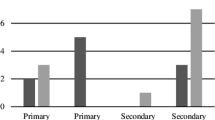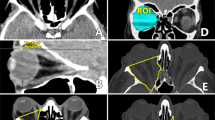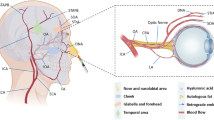Abstract
Aim
To describe the features of an orbital infarction syndrome arising after prolonged orbital pressure during drug-induced stupor in young people.
Patients and methods
The clinical presentation and course for drug-induced orbital infarction is described, based on a retrospective review of clinical notes and imaging.
Results
Two cases of orbital infarction syndrome, due to prolonged orbital compression caused by sleeping with pressure on the orbit during drug-induced stupor, are described. Both patients presented with very poor vision and mydriasis, marked periorbital swelling with some pain, and complete external ophthalmoplegia. Whilst the orbital changes and eye movements recovered, the affected eyes had persistent wide mydriasis, and remained blind with marked optic atrophy.
Conclusion
With a mechanism analogous to prolonged orbital pressure due to improper head positioning during neurosurgical procedures, drug-users appear to risk developing an orbital infarction syndrome if they rest with prolonged pressure on the orbit during a drug-induced stupor.
This is a preview of subscription content, access via your institution
Access options
Subscribe to this journal
Receive 18 print issues and online access
$259.00 per year
only $14.39 per issue
Buy this article
- Purchase on Springer Link
- Instant access to full article PDF
Prices may be subject to local taxes which are calculated during checkout


Similar content being viewed by others
References
Borruat F-X, Bogousslavsky J, Uffer S, Kainguti G, Schatz NJ. Orbital infarction syndrome. Ophthalmology. 1993;100:562–8.
Jampol LM, Goldaum M, Rosenberg M, Bahr R. Ischemia of ciliary arterial circulation from ocular compression. Arch Ophthalmol. 1975;93:1311–7.
Bogousslavsky J, Pedrozzi DL, Borruat F-X, Regli F. Isolated complete orbital infarction: a common carotid occlusion syndrome. Eur Neurol. 1991;31:72–6.
Galetta SL, Leahey A, Nichols CW, Raps EC. Orbital ischemia, ophthalmoparesis, and carotid dissection. J Clin Neuroophthalmol. 1991;11:284–7.
Rao R, Shetty AP, Nagesh CP. Orbital infarction syndrome secondary to rhino-orbital mucormycosis in a case of COVID-19: clinico-radiological features. Indian J Ophthalmol. 2021;69:1627–30.
Hayreh SS. The ophthalmic artery. III. Branches. Br J Ophthalmol. 1962;46:212–47.
Roth S. Perioperative visual loss: what do we know, what can we do? Br J Anaesth. 2009;103:i31–40.
Jayam AV, Hass WK, Carr RE, Kumar AJ. Saturday night retinopathy. J Neurol Sci. 1974;22:413–8.
van Stavern GP, Gorman M. Orbital infarction after cocaine use. Neurology. 2002;27:642–3.
Malihi M, Turbin RE, Frohman LP. Saturday night retinopathy with ophthalmoplegia: a case series. Neuroophthalmology. 2015;39:77–82.
Kozlova A, Paranjpe V, North VS, Kim E. Compressive ophthalmic artery occlusion and orbitopathy: a case of Saturday night retinopathy. Orbit. 2021;16:1–2.
Author information
Authors and Affiliations
Contributions
GER initiated the work; all authors contributed to data acquisition and writing.
Corresponding author
Ethics declarations
Competing interests
The authors declare no competing interests.
Additional information
Publisher’s note Springer Nature remains neutral with regard to jurisdictional claims in published maps and institutional affiliations.
Rights and permissions
Springer Nature or its licensor (e.g. a society or other partner) holds exclusive rights to this article under a publishing agreement with the author(s) or other rightsholder(s); author self-archiving of the accepted manuscript version of this article is solely governed by the terms of such publishing agreement and applicable law.
About this article
Cite this article
Sawhney, A., Vahdani, K. & Rose, G.E. Orbital infarction during drug abuse: tissues of the globe do not appear to recover function. Eye 38, 198–201 (2024). https://doi.org/10.1038/s41433-023-02658-x
Received:
Revised:
Accepted:
Published:
Issue Date:
DOI: https://doi.org/10.1038/s41433-023-02658-x



